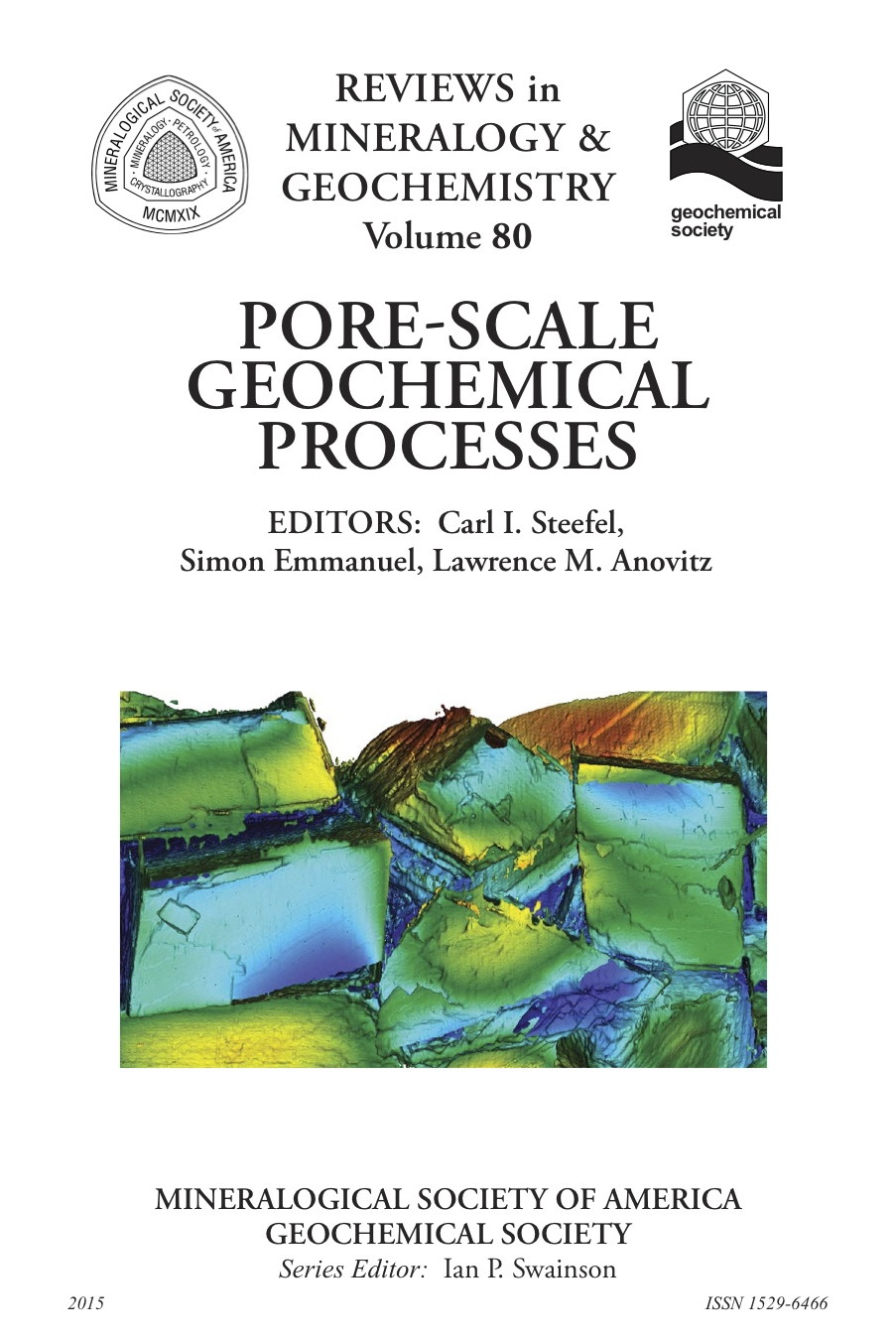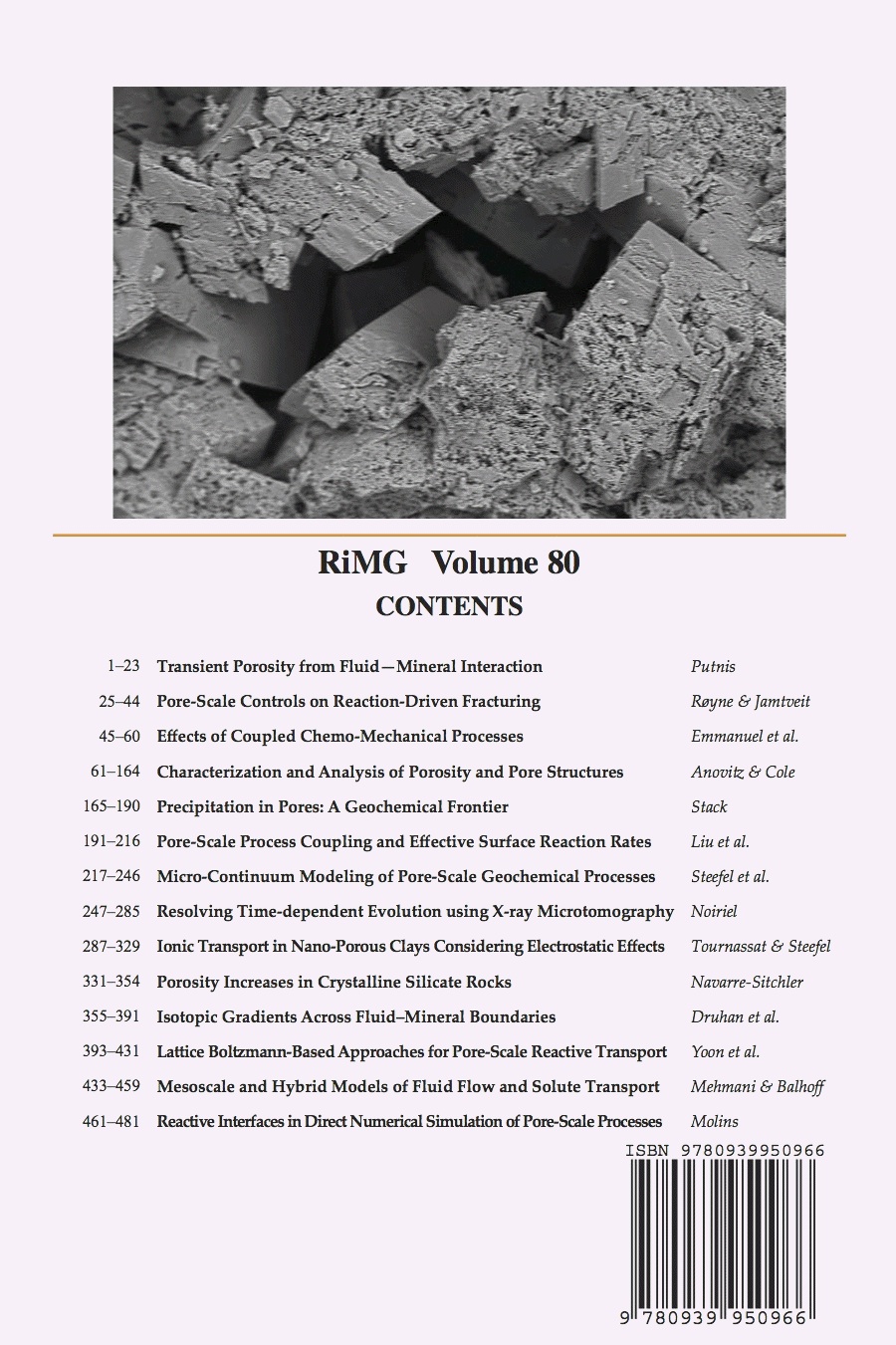

Mineralogical Society of America, Founded December 30, 1919
Order Publications Online (25% discount for MSA, CMS and GS members, except shipping)
MinPubs.org Pay-Per-View GeoScienceWorld Open Access


2015, i-xiv + 491 pages. ISBN 978-0-939950-96-6
The pore scale is readily recognizable to geochemists, and yet in the past it has not received a great deal of attention as a distinct scale or environment that is associated with its own set of questions and challenges. Is the pore scale merely an environment in which smaller scale (molecular) processes aggregate, or are there emergent phenomena unique to this scale? Is it simply a finer-grained version of the “continuum” scale that is addressed in larger-scale models and interpretations? We would argue that the scale is important because it accounts for the pore architecture within which such diverse processes as multi-mineral reaction networks, microbial community interaction, and transport play out, giving rise to new geochemical behavior that might not be understood or predicted by considering smaller or larger scales alone.
Fortunately, the last few years have seen a marked increase in the interest in pore-scale geochemical and mineralogical topics, making a Reviews in Mineralogy and Geochemistry volume on the subject timely. The volume had its origins in a special theme session at the 2015 Goldschmidt Conference, Prague, Czech Republic, August 16-21, 2015, where at least some of the contributors to this volume gave presentations. From the diversity of pore-scale topics in the session that spanned the range from multi-scale characterization to modeling, it became clear that the time was right for a volume that would summarize the state of the science. Based in part on the evidence in the chapters included here, we would argue that the convergence of state of the art microscopic characterization and high performance pore scale reactive transport modeling has made it possible to address a number of long-standing questions and enigmas in the Earth and Environmental Sciences. Among these is the so-called “laboratory-field discrepancy” in geochemical reaction rates, which may be traceable in part to the failure to consider porescale geochemical issues that include chemical and physical heterogeneity, suppression of precipitation in nanopores, and transport limitations to and from reactive mineral surfaces.
This RiMG volume includes contributions that review experimental, characterization, and modeling advances in our understanding of pore-scale geochemical processes. The volume begins with chapters authored or co-authored by two of the éminences grises in the field of pore-scale geochemistry and mineralogy, two who have made what is perhaps the strongest case that the pore-scale is distinct and requires special consideration in geochemistry. The chapter by Andrew Putnis gives a high level overview of how the pore-scale architecture of natural porous media impacts geochemical processes, and how porosity evolves as a result of these. The chapter makes the first mention of what is an important theme in this volume, namely the modification of thermodynamics and kinetics in small pores. In a chapter authored by Røyne and Jamtveit, the authors investigate the effects of mineral precipitation on porosity and permeability modification of rock. Their principal focus is on the case where porosity reduction results in fracturing of the rock, in the absence of which the reactions will be suppressed due to the lack of pore space. The next chapter by Emmanuel, Anovitz, and Day-Stirrat addresses chemo-mechanical processes and how they affect porosity evolution in geological media. The next chapter by Anovitz and Cole provides a comprehensive review of the approaches for characterizing and analyzing porosity in porous media. Small angle neutron scattering (SANS) plays prominently as a technique in this chapter. Stack presents a review of what is known about mineral precipitation in pores and how this may differ from precipitation in bulk solution. Liu, Liu, Kerisit, and Zachara focus on porescale process coupling and the determination of effective (or upscaled) surface reaction rates in heterogeneous subsurface materials. Micro-continuum modeling approaches are investigated by Steefel, Beckingham, and Landrot, where the case is made that these may provide a useful tool where the computationally more expensive pore and pore network models are not feasible. The next chapter by Noiriel pursues the focus on characterization techniques with a review of X-ray microtomography (especially synchrotron-based) and how it can be used to investigate dynamic geochemical and physical processes in porous media. Tournassat and Steefel focus on a special class of micro-continuum models that include an explicit treatment of electrostatic effects, which are particularly important in the case of clays or clay-rich rock. Navarre-Sitchler, Brantley, and Rother present an overview of our current understanding of how porosity increases as a result of chemical weathering in silicate rocks, bringing to bear a range of characterization and modeling approaches that build toward a more quantitative description of the process. In the next chapter, Druhan, Brown, and Huber demonstrate how isotopic gradients across fluid–mineral boundaries can develop and how they provide insight into pore-scale processes. Yoon, Kang, and Valocchi provide a comprehensive review of lattice Boltzmann modeling techniques for pore-scale processes. Mehmani and Balhoff summarize mesoscale and hybrid models for flow and transport at the pore scale, including a discussion of the important class of models referred to as “pore network” that typically can operate at a larger scale than is possible with the true pore-scale models. Molins addresses the problem of how to represent interfaces (solid–fluid) at the pore scale using direct numerical simulation.
Catherine A. Peters (2016) Book Review: Pore-Scale Geochemical Processes, RIMG Volume 80, American Mineralogist, Volume 101, pages 2574–2575. Download
Title Page
p. i Download (126 KB) 
Copyright
p. ii Download (45 KB) 
From the Series Editor
p. iii-v Download (107 KB) 
Preface
p. iii-v Download (119 KB) 
Table of Contents
p. vii-xiv Download (122 KB) 
Chapter 1. Transient Porosity Resulting from Fluid–Mineral Interaction and its Consequences
by Andrew Putnis, p. 1-24 Download (546 KB) 
Chapter 2. Pore-Scale Controls on Reaction-Driven Fracturing
by Anja Røyne, Bjørn Jamtveit, p. 25-44 Download (1 MB) 
Chapter 3. Effects of Coupled Chemo-Mechanical Processes on the Evolution of Pore-Size Distributions in Geological Media
by Simon Emmanuel, Lawrence M. Anovitz, Ruarri J. Day-Stirrat, p. 45-60 Download (712 KB) 
Chapter 4. Characterization and Analysis of Porosity and Pore Structures
by Lawrence M. Anovitz, David R. Cole, p. 60-164 Download (3.7 MB) 
Errata for Chapter 4. On page 112, Figure 32 should be identified as Figure 31. Figure 32 was inadvertently left out of the chapter. (Download (309 KB))
Chapter 5. Precipitation in Pores: A Geochemical Frontier
by Andrew G. Stack, p. 165-190 Download (672 KB) 
Chapter 6. Pore-Scale Process Coupling and Effective Surface Reaction Rates in Heterogeneous Subsurface Materials
by Chongxuan Liu, Yuanyuan Liu, Sebastien Kerisit, John Zachara, p. 191-216 Download (764 KB) 
Chapter 7. Micro-Continuum Approaches for Modeling Pore-Scale Geochemical Processes
by Carl I. Steefel, Lauren E. Beckingham, Gautier Landrot, p. 217-246 Download (784 KB) 
Chapter 8. Resolving Time-dependent Evolution of Pore-Scale Structure, Permeability and Reactivity using X-ray Microtomography
by Catherine Noiriel, p. 247-286 Download (2.7 MB) 
Chapter 9. Ionic Transport in Nano-Porous Clays with Consideration of Electrostatic Effects
by Christophe Tournassat, Carl I. Steefel, p. 287-330 Download (1.2 MB) 
Chapter 10. How Porosity Increases During Incipient Weathering of Crystalline Silicate Rocks
by Alexis Navarre-Sitchler, Susan L. Brantley, Gernot Rother p. 331-354 Download (596 KB) 
Chapter 11. Isotopic Gradients Across Fluid–Mineral Boundaries
by Jennifer L. Druhan, Shaun T. Brown, Christian Huber, p. 355-392 Download (998 KB) 
Chapter 12. Lattice Boltzmann-Based Approaches for Pore-Scale Reactive Transport
by Hongkyu Yoon, Qinjun Kang, Albert J. Valocchi, p. 393-432 Download (675 KB) 
Chapter 13. Mesoscale and Hybrid Models of Fluid Flow and Solute Transport
by Yashar Mehmani, Matthew T. Balhoff, p. 433-460 Download (1.3 MB) 
Chapter 14. Reactive Interfaces in Direct Numerical Simulation of Pore-Scale Processes
by Sergi Molins, p. 461-481 Download (2.6 MB) 